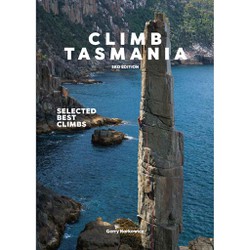Seasonality
Description
Dark, somewhat more broken than it appears from a distance, and often vert wet, this wall contains 2 important routes - The Sydney Route (the first route to breach the main cliffline in 1964), and The Chimes of Freedom (a rite of passage for grade 17 leaders and one of the great climbs in the state).
Like most other areas, the potential for new routes is limitless, with 100's of metres of cliffline, and a number of key pillars yet to have a single pitch on it. There is a lot of loose rock, particularly on The Sydney Route, although clean areas (with no routes on them yet) abound.
Access issues inherited from Frenchmans Cap Area
It's a 25km hike from the Lyell Highway.
Approach
Follow the access notes to the East Face, continue to traverse around the base. For the Sydney Route Direct, head for the high mound directly beneath the route, around 30m L of the nose that marks the L end of the east face. For other routes, stay lower and follow the cliff around. For Chimes of Freedom, stay lower again, before ascending a dangerous couloir (ensure adequate spacing between members of your group and wear a helmet)
Descent notes
Walk up to the summit, and then down the tourist track to Tahune Hut
Ethic inherited from Frenchmans Cap
Trad, but some bolts exist where trad is not possible.
Frenchmans Cap is in The Franklin - Gordon Wild Rivers National Park and subject to the Tasmanian Wilderness Heritage Area Management Plan. Climbing is addressed on pages 143-14 of the plan. Some of the presceriptions related to climbing are:
• The area will be predominantly maintained as a traditional climbing area. • The establishment or maintenance of routes that are protected primarily or exclusively using fixed anchors (i.e. ‘sport’ climbs) is generally prohibited. • Existing routes in the 2013 minor boundary extension that use fixed anchors may be maintained. New routes may be established in existing locations where fixed anchors are utilised subject to approval by PWS. • Based on historical precedence, the occasional limited installation (or replacement) of permanent anchors at Mt Geryon, The Acropolis, Frenchmans Cap and Mt Anne is permitted. • Written authority must be obtained from the PWS before using power-driven equipment to install or replace any permanent anchor in the TWWHA.
Tags
Plan your Trip
Did you know?
Did you know that you can create an account to record, track and share your climbing ascents? Thousands of climbers are already doing this.
Selected Guidebooks more Hide
Author(s): Gerry Narkowicz
Date: 2021
ISBN: 9780646841946
Cracks, sea stacks, big walls, remote exotic locations, volcanic columns, no crowds and your choice of the predominant dolerite, some quartzite and a little sandstone to remind you of the mainland. Many a wilderness climbing experience can be had within a 2hr car trip from the main centers. By Gerry Narkowicz. This guide features 1280 routes.
Accommodations nearby more Hide
Share this
Photos Browse all photos

Bryden Allen on ★★ The Sydney Route 16 - The Devils Staircase

Bryden Allen on ★★ The Sydney Route 16 - Pitch 5?

Melissa Thomas on ★★ The Sydney Route 16 - High on the Sydney Route

★★ The Sydney Route 16 - Instagram
Get a detailed insight with a timeline showing
- Ticks by climbers like you
- Discussions of the community
- Updates to the index by our users
- and many more things.
Login to see the timeline!

